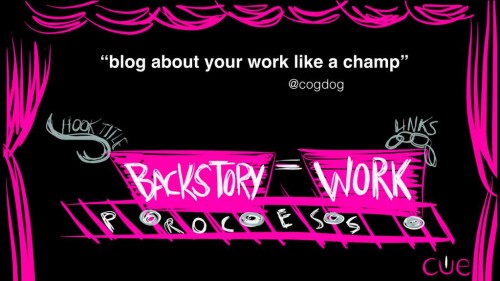
The main premise of the You Show is that you do produce your own show, but also use your own blog to narrate the process, all of the things leading up to the show. These are suggestions, not rules, not commandments, based on our experiences in the Show Your Work business.
The Three Parts
A good showing of your work includes:
You Had Me at The Title
In terms of your blog posts give careful thought to a descriptive title that is more than “My Assignment” or “Movie Project”. The title of your post is what people will glance at from among many other blog posts, so think of it as a headline. Be clever with your post titles. Use metaphors, plays on words, cultural memes, whatever you can aim to grab someone’s interest.
If you glance at something called “Visual Assignment” what does that do as a hook to bring you into wanting to see it?
Show The Work!
What you created ought to be embedded into the body of your post, not just hyperlinked. Don’t send someone elsewhere to see your work, wrap it with your own narrative. Let your audience be viewing it as they read about it.
Set the Scene
As a backstory show some evidence of your thinking behind it. Use a few paragraphs to describe why you chose the assignment or the topic, or what the thing you made means to you. Where did the idea come from? What is its context? What is the story it tells? What does it mean to you? to society? to other media? Why did you even make it? Who or what was the inspiration? Influences? What does it relate to?
Share the meaning of your work and how it is related to the concept of creative expression or just your own connection to it.
Your post should include hyperlinks to reference material (e.g. a link to the Internet Movie Database for a movie, a link to previous work if you have built upon something done earlier, a link to media sources used). Also, links should be within the context of your sentences, not just a URL or “Click here” text.
If this is in response to a particular task, sure to include a hyperlink back to that original assignment. This allows others to see the prompt, as well as other related information. Think links! In addition, it is best to describe in your own post how the assignment is written, so a reader knows the context of the work you are posting. Each blog post should be able to stand on its own as a point of reference for a reader who might only see this single post from your site.
The Process
Think of this part as the part of a DVD that includes the extras- behind the scenes, out takes, director’s commentary.
Again, your task here is more than just making media. Think of all the social media that flies by as just a single image or video. What do you know about it? How did it come to be?
Include in your blog posts a description of how you created it, the software used, techniques/tools within the software, the sources of any media, etc. Think of it as a guide to someone else who might want to recreate what you did.
This the part of the DVD extras menu like “The Making Of My Groovy Assignment”
